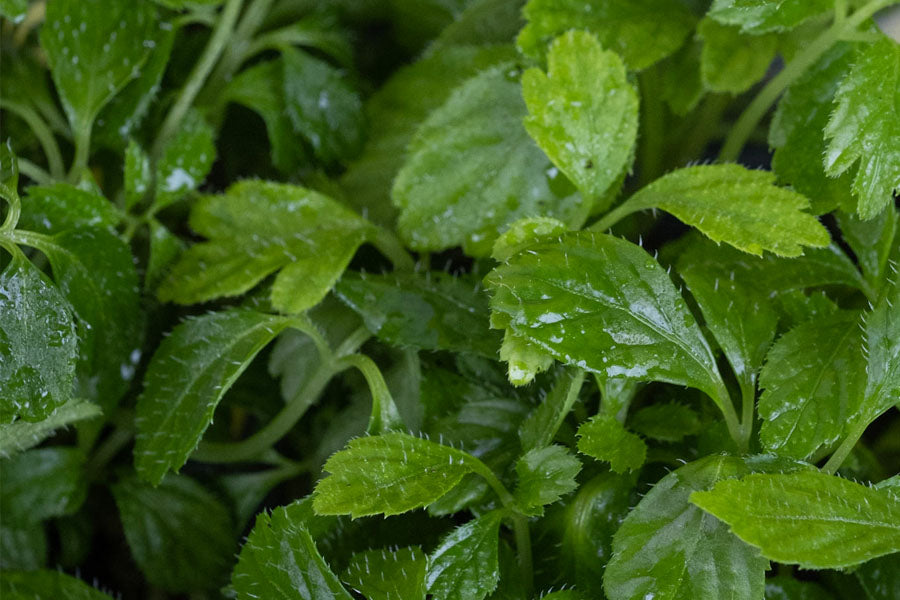Jiaogulan - also called "herb of immortality" - is one of the lesser-known traditional medicinal herbs from Asia. For centuries, the plant, which carries the botanical name "Gynostemma Pentaphyllum", was almost exclusively used in folk medicine in the mountain regions of southern China, where it grows wild.
Traditional Chinese Medicine (TCM) as we know it today, however, originated far away from this in the centre of the country. For this reason, Jiaogulan is not included in TCM's standardised system of remedies and is therefore not as widely used as other medicinal herbs. [16]
Nevertheless, the herb of immortality has a long tradition . In this article you will learn more about the origin and traditional uses of the medicinal plant from China.
Fun Fact, Jiaogulan is also one of the Hero Ingredients in Play It Cool . Here you can find out how your skin benefits from Jiaogulan, and why it is worth incorporating the strengthening eye gel into your skin care ritual.
- Gynostemma Pentaphyllum: History and Botany of the Plant
- Healing through nature: Traditional Uses of Jiaogulan
- Conclusion: Herb of immortality - a myth or reality?
Gynostemma Pentaphyllum: History and Botany of the Plant
Discovery as the “herb of immortality”
As previously mentioned, the use of Jiaogulan was limited to a few regions in Asia for a long time. So how come, after centuries of exclusively being used in folk medicine, the herb suddenly attracted worldwide interest?
In the 1970s, China conducted a large census . It was noticed that the inhabitants of some regions, mainly the province of Guizhou , lived longer than average – often more than 100 years. It turned out that the particularly old inhabitants had regularly consumed Jiaogulan tea throughout their lives. This was not only the birth of the alias "herb of immortality" , but also numerous research projects around the mysterious plant from Asia. [13; 16]
The herb of immortality has other names, including Woman's Ginseng and 5-Leaf Ginseng . Yet Jiaogulan and true ginseng are not botanically related. The name reference has a different reason: During the intensive research on Jiaogulan at the end of the 20th century, a number of ingredients were discovered that were similar or even identical to those of ginseng . [13] We will take a closer look at these later.
Botanical characteristics of the plant
Jiaogulan is a perennial herb. This means that its bulbous roots do not die off in winter, but remain intact underground. As soon as it gets warmer again in spring, the plant forms new shoots.
The plant's height depends very much on external factors; under optimal conditions it can grow up to 8 metres. The leaves are a fresh shade of green and consist of composite five-lobed leaf segments. This optical characteristic is why Jiaogulan is also known as 5-leaf ginseng . During the summer months, the shrub also bears inconspicuous, greenish-white flowers. [13; 20]
Jiaogulan was originally native primarily to China, India, Japan, Korea and Thailand, as well as throughout Malaysia. However, cultivation and care are generally very uncomplicated. If you wish, you can therefore even grow the herb of immortality yourself in your garden or as a potted plant . [4; 13]
In its traditional use as a medicinal herb, the leaves are either eaten pure or used to make tea. The taste of the herb is sweetish-tart. The plant parts of Jiaogulan can also be processed into extracts, as is common for medicinal plants. These then contain a particularly high proportion of the active ingredients.
Healing through nature: Traditional Uses of Jiaogulan
Active ingredients in Jiaogulan
As mentioned before, some of the active ingredients of Jiaogulan are closely related or even identical to those of ginseng, the ginsenosides .
This discovery came as a particular surprise to researchers. This is because the development of specific secondary plant substances normally takes place exclusively within a plant family. Ginseng, however, belongs to the ginseng family (Araliaceae) [6], while Jiaogulan belongs to the gourd family (Cucurbitaceae). [4]
The active ingredients of Korean ginseng are called ginsenosides, while the related substances in jiaogulan are called gypenosides. Both groups structurally belong to the substance class of saponins. [16]
The term saponin is derived from the Latin "sapo" for soap. They are so called because they can produce a soap-like foam when combined with water. [21] The effects of saponins on the human organism are very versatile. Plant parts containing saponins are known, among other things, for their expectorant, anti-inflammatory and immunostimulant properties.
In addition to gypenosides, jiaogulan also contains valuable flavonoids such as rutin and quercetin . [15]
Flavonoids are the colouring compounds of many fruits and vegetables. Depending on the structure, they sometimes serve to attract pollinators or act as protection against herbivores. From a health point of view, they are particularly popular for their antioxidant and antibacterial effects.
The gypenosides and flavonoids are responsible for the majority of Jiaogulan's healing properties. Since the worldwide discovery of the climbing plant in the 1970s, they have been the subject of numerous studies.
According to scientists, the following fields of use are particularly promising:
Diabetes and blood sugar regulation
There are numerous studies looking at the effects of jiaogulan on diabetes and blood sugar levels .
In one clinical study, 24 subjects with type-2-diabetes drank jiaogulan-tea or placebo-tea daily for 12 weeks. Both groups also received advice on diet and exercise. The jiaogulan tea led to a significant improvement in both short- and long-term blood glucose metrics in the treatment group compared to the control group. [10]
In another research project on 25 subjects , it was found that combining a drug proven effective in diabetes with an extract of jiaogulan for 8 weeks resulted in better blood glucose levels than treatment with the prescription drug alone. [11]
The herb of immortality was able to prove its blood sugar-lowering properties in various other preclinical studies. In addition, the gypenosides it contains seem to have a positive effect on the insulin resistance of type 2 diabetes, which is usually the underlying cause . [25] This means that the body cells of patients with the disease are less sensitive to the hormone insulin. As a result, their cells absorb less glucose - i.e. sugar - from the blood. The blood sugar level rises.
Another preclinical study suggests that jiaogulan and grape seed extract enhance one another's positive effect on insulin resistance. Their combined effect in the study was even greater than the sum of their individual effects. [27] This kind of mutually promoting effect is also called a synergy (from the greek word "synergia" - "the cooperation"). [1]
Due to the small number of participants, the studies on humans are certainly not representative yet. Nevertheless, they indicate that jiaogulan could be an effective option in supporting established treatment methods for diabetes.
Treatment of lipometabolic disorders
Jiaogulan also shows promise in the treatment of dyslipidemia.
In a clinical study, the Chinese plant was able to lower the so-called cholesterol, triglyceride and LDL levels in the blood. Elevated levels of these three substances in the serum are associated with the development of various public diseases and are therefore considered risk factors.
The HDL values of the jiaogulan group, on the other hand, increased in the course of the study. HDL is a protein that is partly responsible for the removal of excess cholesterol. Therefore, an increase in the HDL value is considered positive.
The positive effects of the medicinal plant on the blood lipid values could be confirmed in further studies.
They also suggest that a medicinal use of jiaogulan may be beneficial as a treatment for the condition known as "non-alcoholic fatty liver". However, more research is needed in this area. [16; 17]
Antioxidant properties
The herb of immortality has a remarkable antioxidant effect on the body. [14; 16]
This means it can help to protect you from oxidative stress and its negative effects. Oxidative stress occurs when the number of free radicals in your body exceeds the number of antioxidants present.
Free radicals are oxygen compounds with an unpaired electron. Since these molecules desperately need an electron to achieve stability, they are extremely reactive. They can snatch the missing electron from other molecules, which in turn leads to the formation of a new radical - a vicious cycle.
Antioxidants can neutralise free radicals and therefore prevent them from attacking your cells.
The presence of free radicals in your body is quite normal. It is the excess of such compounds over radical scavengers, i.e. "oxidative stress", that could have a damaging effect on your health in the long term . However, you can prevent this by adopting a healthy lifestyle.
According to various studies, Jiaogulan can reduce the extent and effects of oxidative stress. The plant is particularly known for its ability to increase the concentration of superoxide dismutase (SOD) in the body. SOD is one of the body's most important antioxidants. According to researchers, its concentration is proportionally related to the life expectancy of different animal species . So maybe the herb of immortality really can increase the life expectancy of humans as well. However, more research is needed to answer this question. [26]
Adaptogenic properties
Jiaogulan is also known in traditional Chinese medicine for its adaptogenic effects. This means that the plant can support your body's ability to cope with stress as well as help to improve your performance. [7]
The adaptogenic properties of jiaogulan were investigated in a preclinical study. Treatment was either a saline solution (placebo) or extracts of Gynostemma pentaphyllum for 28 days. At the end of the study, the physical performance of the group treated with jiaogulan was greater than that of the placebo group. Some blood parameters that may be related to fatigue had also improved with jiaogulan treatment. [18]
Other areas of application
The described use of jiaogulan for diabetes, lipid metabolism disorders, as an antioxidant and as an adaptogen is best researched at the present time. However, the consumption of the Chinese medicinal herb could also be beneficial for other diseases:
There are preclinical studies on the effect of jiaogulan on gastric ulcers [8; 19], Parkinson's disease [2; 24] and allergic asthma [3; 9]. Furthermore, regulative effects of the plant on the immune system [12; 22; 23] and body weight [5] are being discussed.

Conclusion: Is the Herb of Immortality a Myth or Reality?
Similar in its effect , but lesser known than Korean ginseng , for many centuries Jiaogulan was used exclusively in selected regions of Asia for folk medicine . At the end of the 20th century, a connection was discovered between the consumption of Jiaogulan tea and the particular longevity of some of China's inhabitants . This is how the plant received the nickname "herb of immortality".
Since then, the effects of Jiaogulan on various diseases have been researched intensively. According to studies, the herb seems to be particularly promising in the supportive treatment of diabetes and lipid metabolism disorders and as an antioxidant and adaptogen .
Whether and why the herb of immortality could really have a life-prolonging effect has not yet been conclusively determined. However, it is assumed that the antioxidant and adaptogenic properties of the plant could play a role in this. Furthermore, researchers suspect a strong connection between the hormone insulin and the biological ageing process. Thus, the regulating effect of jiaogulan on insulin and blood sugar levels could also be of crucial importance . [7]

